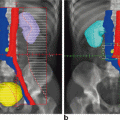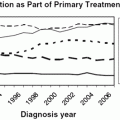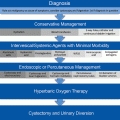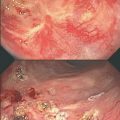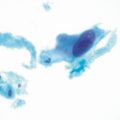Mechanism
Explanation
Clinical example
Comments
Spatial cooperation
Working on different anatomical regions of the body to improve outcome without additive toxicity
RT in SCLC
Chemotherapy does not cross blood brain barrier which is a sanctuary site for SCLC cells
Protection of normal tissue
Drug interacts with radiation in a way to prevent harmful effects on adjacent normal tissue
Amifostine is used in head and neck cancer to prevent radiation induced xerostomia
Clinical benefit is not proven in clinical trials
Biological cooperation
The drug targets cells that escape RT within the tumor tissue itself
Tirapazamine in head and neck cancer
Newer concept that needs clinical evidence
Temporal modulation
Drug targets cancer cells in between RT fractions by inhibiting repair, repopulation, redistribution, and reoxygenation
Cetuximab in head and neck cancer
Needs clinical evidence with concurrent chemoradiation
Chemotherapeutic Agents Used as Radiosensitizers in Pelvic Malignancies
Fluoropyrimidines (5-Fluorouracil and Capecitabine)
5-Flurouracil (5-FU) is certainly one of the most commonly used radiosensitizing drugs. It is a pyrimidine analog of uracil and through its inhibition of folate metabolism works as an antimetabolite. While it interacts with both DNA and RNA, its radiosensitizing effects are primarily due to inhibition of thymidylate synthase and eventually DNA biosynthesis [10]. 5-FU has been used both as a bolus and by continuous infusion in the initial CRT trials, but currently continuous infusion is the preferred method owing to better side effect profile, the short half life of 5-FU, and phase III trials in rectal cancer establishing continuous infusion to be better in terms of treatment outcomes [11]. Combined CRT with cisplatin or 5-FU is the current standard of care in the treatment of head and neck cancer and many gastrointestinal cancers, including rectal and anal cancers.
Capecitabine is an oral 5-FU prodrug, which goes through a three-step enzymatic process to be transformed into its active form. Thymidine phosphorylase (TP) is a key rate-limiting enzyme in this conversion process. Since the TP activity is higher in tumor tissue and liver, it results in a preferential effect at these sites. Randomized controlled trials (RCTs) comparing infusional 5-FU with capecitabine in neoadjuvant CRT treatment of rectal cancer have established therapeutic equivalency and perhaps superiority of capecitabine over 5-FU [12, 13]. The ease of administration of capecitabine is unbeatable when combined with CRT. It is to be noted that capecitabine and 5-FU have slightly different toxicity profiles. The most important acute toxicities related to 5-FU are nausea, vomiting, fatigue, myelosuppression, hand-foot syndrome (HFS), mucositis of the gastrointestinal tract, cardiotoxicity (arrhythmias and coronary ischemia), and cerebellar neurotoxicity (ataxia and nystagmus). While capecitabine has a similar toxicity profile to 5-FU, some trials have shown that it causes less hematological toxicity and more dermatological toxicity (HFS) as well as fatigue [13]. The toxicity of 5-FU and its analogues is dose dependent except in dihydropyrimidine dehydrogenase deficient patients who are highly sensitive to even small doses owing to their impaired ability to metabolize these drugs.
Finally, capecitabine, but not 5-FU, is affected both by compliance and also pharmacokinetic issues such as absorption, drug interaction, and renal clearance (especially in elderly patients).
Platinum Agents
Cisplatin (Cis-diamminedichloroplatinum; CDDP) is an alkylating agent. CDDP is a classic drug used in the treatment of many cancers and it also works as an excellent radiosensitizer. The drug forms covalent bonds with nucleotide bases in the DNA strand, resulting in inter- or intrastrand crosslinks (adducts). This results in single strand breaks, which are detected and removed by DNA mismatch repair processes. The potentially repairable single-strand break becomes an irreparable double-strand break when combined with radiation. An inherent resistance to radiosensitization by cisplatin and carboplatin (but not oxaliplatin) is manifest by mismatch repair defective cells [14]. A large body of randomized phase III trials supports the beneficial effect of concurrent CRT with CDDP in improving overall survival (OS) for patients with cervical and bladder cancer compared to either modality alone.
Carboplatin is a second-generation platinum analogue that was introduced for clinical use in 1992. Comparative trials in many different malignancies (ovary, germ cell, bladder, NSCLC, and head and neck) have established a better toxicity profile for carboplatin over cisplatin. However, cisplatin has mostly superior therapeutic efficacy compared to carboplatin, especially in the setting of combined modality therapy.
Oxaliplatin is a third generation platinum analogue, which is currently under study as a radiosensitizer [15]. The DNA nucleoside crosslinks formed by oxaliplatin are not repaired by the DNA mismatch repair system. Oxaliplatin is therefore unique as it can be effective against DNA mismatch repair deficient cells which are resistant to CRT with cisplatin and carboplatin [14]. Despite this interesting observation, the role of oxaliplatin as a radiosensitizer remains controversial and undetermined in last 13 years [16]. The results of several neoadjuvant CRT rectal cancer trials [12, 17–19] have shown that the addition of oxaliplatin to the preoperative CRT regimen with either 5-FU or capecitabine is associated with higher toxicity without improving OS, disease-free survival, or pathological CR. Therefore, at this time it should not routinely be used in combination with radiation therapy. The most common acute toxicities of cisplatin include nausea, vomiting, alopecia, myelosuppression, nephrotoxicity (azotemia, acute renal failure, hyperuricemia), allergic reaction, and neurotoxicity (peripheral neuropathy, ototoxicity) [20]. Carboplatin shares the same toxicity profile; however nausea, vomiting, neurotoxicity, and nephrotoxicity are relatively less. Cisplatin, and the platins in general, can also cause significant late toxicity. Cisplatin has been widely used for the treatment of young, germ cell tumor (GCT) patients, providing long-term data on delayed toxicity at least for male patients. Nephrotoxicity and neurotoxicity continue to be a major problem. About 20–30 % of GCT patients treated with curative intent can have irreversible renal damage resulting in persistent reduction of glomerular filtration rate. Similarly, persistent peripheral neuropathy and ototoxicity has been reported in 20–40 % and ototoxicity alone in 20 % of GCT patients [21]. Cardiovascular toxicity, predominantly ischemic heart disease and resultant complications, has been well described in GCT patients [22].
Mitomycin C
Mitomycin C is an antibiotic derived from Streptomyces caespitosus. It is inactive as such, but reduction by DT-diaphorase (DTD) and other reductases results in activation of the drug [23]. It is an alkylating agent and the mechanism of action is similar to platinum drugs. Additionally, mitomycin C is an effective cytotoxic agent even under hypoxic conditions [6]. Mitomycin C is not cell cycle specific as opposed to platinum drugs. Although controversial, some reports suggest that bioactivity of mitomycin C in tissue is correlated with its DTD concentration. Mitomycin C is a potent radiosensitizer and active against many tumor types but is primarily used for the combined modality treatment of locally advanced anal cancer in combination with 5-FU. Common acute toxicities include nausea, vomiting, myelosuppression, acute renal failure, and alopecia. The complication of hemolytic uremic syndrome (HUS)/thrombotic thrombocytopenia purpura (TTP) is also seen with this drug and is potentially life threatening. Due to its significantly higher toxicity rate when combined with radiation, e.g., 36 % of the study population suffered grade ≥ 3 toxicity in a cervical cancer trial, it is often replaced by platinum drugs [24]. Furthermore, some acute toxicities continue for long periods of follow-up and bowel complications (bleeding, stricture, obstruction, perforation, or fistula formation) are especially high, accounting for about 15 % morbidity in cervical cancer patients [25].
Androgen Deprivation Therapy
Huggins and Hodges first described the role of androgen in metastatic prostate cancer [26]. The androgen receptor is central to the growth and progression of prostate cancer and therefore androgen deprivation therapy (ADT) has been the backbone of prostate cancer treatment. There is no doubt that ADT inhibits the growth of the primary tumor as well as controlling micrometastatic disease [27]. Prostate cancer patients with high-risk locally advanced disease are traditionally treated with external beam radiation therapy and ADT. This approach is based upon the results of many phase III, RCTs showing improvement in OS as well as disease-specific survival in patients treated with combined modality therapy as compared to RT or ADT alone [28–30]. Some studies in tumor xenograft and animal models suggest that ADT positively interacts with radiation therapy to achieve maximal cytotoxic effect. However, it is as yet unclear whether ADT sensitizes prostate cancer cells to RT [31]. The side effects of ADT include hot flashes, skeletal complications (osteopenia, osteoporosis, and fractures), sexual dysfunction (erectile dysfunction, decreased libido), metabolic derangement (increased body mass index, hyperlipidemia), cognitive and mood changes, and poor quality of life (QOL) [27].
Hydroxyurea
Hydroxyurea was first recognized and used as a radiosensitizer in the 1960s [23]. It inhibits ribonucleotide reductase resulting in inhibition of DNA synthesis. It is a cell cycle-specific agent that adds to its potency when combined with radiation. In addition, hydroxyurea is also effective under hypoxic conditions and can impair the repair of near fatal DNA damage after radiation resulting in cell death. The most common acute toxicities of hydroxyurea are myelosuppression, abnormal liver enzymes, and renal impairment. Hydroxyurea can be leukemogenic with long-term use. A recent systematic review analyzing eight RCTs using hydroxyurea as the radiosensitizer in cervical cancer concluded poor OS benefit. The authors summarized that there is inadequate evidence to support the use of hydroxyurea in treatment of cancer of cervix [32] and therefore, hydroxyurea is almost never used in the treatment of pelvic malignancies in the United States of America (USA).
Risk Factors and an Overview of Toxicities
Risk factors: Patient Related and Treatment Related
The risk factors for toxicity with use of combined modality therapy can be separated into patient-related and treatment-related factors. However, these are not completely independent of each other and should rather be considered as codependent. The patient-related risk factors include age, performance status, and end organ function, including renal, liver, and bone marrow reserve. Most combined chemoradiotherapy trials include only patients under the age of 70 years with a few trials having an age cut off of ≤ 75 years [33, 34]. Additionally, the trial inclusion criteria often require that patients have a performance status of ≤ 2 and normal renal, liver, and bone marrow function indirectly indicating the importance of intact end organ function for CT clearance [2, 33, 34].
The treatment-related side effects of radiation are mainly dependent upon the treatment volume and radiation dose [20]. For example, Albuquerque et al. studied factors including age, body mass index, transfusions, and bone marrow volumes irradiated to assess the radiation-related predictors of hematological toxicity due to radiation therapy [35]. In a multivariate logistic regression analysis, they found that if the volume of bone receiving 20 Gy in the pelvis exceeds 80 %, there is significantly higher risk of hematological toxicity of grade ≥ 2 (odds ratio 4.5, 95 %, confidence interval, 1.08–18.69, p < 0.05) [35]. The toxicities of the commonly used CT agents for pelvic malignancies have been reviewed above and these are clearly related to the dose, number of cycles, and pharmacokinetics of the drugs. Some of these factors will be further elaborated in the discussion about specific clinical trials below.
Specific Toxicities
Toxicity due to combined chemoradiotherapy is usually grouped into acute and late/chronic categories. Although previously published studies have used different definitions for acute and late toxicities, for the purposes of this review we will define acute toxicity as any adverse effect occurring after CRT and within 90 days of treatment completion in concordance with other authors [20, 36]. Late/chronic toxicity will be defined as any adverse effect occurring after 90 days. Generally, acute toxicity is considered to be reversible; conversely late toxicity is often permanent and has dramatic effects on QOL.
The most significant acute toxicities are hematologic (leukopenia, granulocytopenia, thrombocytopenia, and anemia) and gastrointestinal (nausea, vomiting, diarrhea, mucositis, and abdominal pain). Other less common acute toxicities include genitourinary (increased frequency, incontinence, dysuria, urinary obstruction, and renal failure), cutaneous (dermatitis, skin ulcerations), and neurologic toxicities. The details of each of these toxicities with combined therapy as compared to radiation therapy alone will be discussed below (see Tables 6.2, 6.3, and 6.4).
Table 6.2
The grade 3 and 4 acute toxicities as reported in chemoradiation trials by cancer site. Where the percentage of adverse effect not provided, it was calculated by dividing number of patient with the adverse effect by the total number of patients in that arm. If the toxicity is not listed in the first column but provided in the clinical trial it was grouped under category “other”
Acute toxicity | Trials | ||||||||||||||||||||||||||||||||||
|---|---|---|---|---|---|---|---|---|---|---|---|---|---|---|---|---|---|---|---|---|---|---|---|---|---|---|---|---|---|---|---|---|---|---|---|
Cervical cancer | Bladder cancer | Prostate cancer | Rectal cancer | Anal cancer | |||||||||||||||||||||||||||||||
Whitney et al. [2] | Rose et al. [41] | Keys et al. [42] | Peters et al. [34] | Morris et al. [39] | Pearcey [33] | James et al. 2010 | Roach et al. [56] | Bolla et al. [28] | Pilepich et al. [29] | Denham et al. [53] | Bosset et al. [4] | Bujko et al. [60] | Gerard et al. 2006 | James et al. [5] and 2010 (Not Necessarily G3/4) | Bartelink et al. [64] (Unclear N in count or %) | Ajani et al. [65] | |||||||||||||||||||
CRT (CF) % | CRT (HU) % | CRT (C) | CRT (CFH) | CRT (H) | CRT | RT | CRT | RT | CRT | RT | CRT (CDDP) | RT | CRT | RT | ADT + RT | RT | ADT + RT | RT | CRT | RT | CRT | RT | CRT | RT | CRT | RT | CRT | RT | CRT | RT | CRT | RT | CRT (CDDP) | CRT (MMC) | |
Overall | – | – | – | – | – | – | – | – | – | – | – | – | – | 36 | 27.5 | 2 | 4 | – | – | – | – | – | – | 54.3 | 37.7 | – | – | 15 | 2.9 | 48 | 38.5 | – | – | 83 | 87 |
Hematological (other) | 3.0 | 5.9 | 15 | 33 | 18 | 21.3 | 1.6 | – | – | 73 | 2 | 6 | 0 | – | – | – | – | – | – | – | – | – | – | – | – | – | – | – | – | – | – | – | – | 42.1 | 61.4 |
Thrombocytopenia | 0 | 0.5 | 2 | 4 | 1 | – | – | 0.8 | 0 | – | – | – | – | – | – | – | – | 0 | 1 | – | – | – | – | 1.8 | 0.5 | – | – | – | – | 4.7 | 0 | – | – | – | – |
Leucopenia | 3.6 | 24.7 | 23 | 46 | 21 | – | – | 35 | 0.9 | – | – | – | – | – | – | – | – | 0 | 1 | – | – | – | – | 7 | 0.8 | – | – | – | – | 6.5 | 0 | – | – | – | – |
Anemia | – | – | – | – | – | – | – | 3.2 | 0 | – | – | – | – | – | – | – | – | 1 | 0 | – | – | – | – | – | – | – | – | – | – | – | – | – | – | – | – |
Granulocytopenia | – | – | – | – | – | – | – | 28.6 | 2.6 | – | – | – | – | – | – | – | – | – | – | – | – | – | – | – | – | – | – | – | – | – | – | – | – | – | – |
Genitourinary | 1.2 | 1.6 | 5 | 2 | 3 | 1.6 | 3.2 | – | – | 2 | 0 | 3 | 1 | – | – | – | – | 7 | 9 | – | – | – | – | 5.3 | 5.8 | – | – | – | – | 1 | 0.3 | – | – | 3.3 | 3.4 |
Renal failure | – | – | – | – | – | – | – | 0 | 0 | – | – | – | – | – | – | – | – | – | – | – | – | – | – | – | – | – | – | – | – | ||||||
Cutaneous | 2.4 | 1.6 | 2 | 5 | 4 | 0 | 2.1 | 3.2 | 0 | 5 | 1 | 3 | 0 | – | – | – | – | < 1 | 2 | – | – | – | – | 26 | 20 | – | – | – | – | 17.1 | 13.6 | 29 | 26 | 41.25 | 47.8 |
Neurological | 0 | 0 | 1 | 1 | 2 | 1 | 0 | – | – | – | – | 2 | 0 | – | – | – | – | – | – | – | – | – | – | – | – | – | – | – | – | – | – | – | – | 5.6 | 5 |
Gastrointestinal | 7.7 | 4.3 | 12 | 18 | 14 | 14 | 5 | – | – | – | – | 16 | 1 | – | – | – | – | – | – | – | – | – | – | – | – | – | – | – | – | 4.7 | 1.7 | – | – | 45.6 | 35.4 |
Diarrhea | – | – | – | – | – | – | – | 9.8 | 0 | – | – | – | – | – | – | – | – | 5 | 11 | – | – | – | – | 34 | 17 | – | – | – | – | – | – | 10 | 4 | – | – |
Nausea and vomiting | – | – | – | – | – | – | – | 26 | 3.4 | 15 | 2 | – | – | – | – | – | – | < 1 | 0 | – | – | – | – | 7.5 | 0.8 | – | – | – | – | – | – | – | – | 32.5 | 15.3 |
Abdominal pain/pain | – | – | 0 | 1 | 0 | – | – | 3.2 | 0.8 | – | – | – | – | – | – | – | – | – | – | – | – | – | – | – | – | – | – | – | – | – | – | – | – | 23.7 | 17.1 |
Bowel and rectal abnormailities | – | – | – | – | – | – | – | 1.6 | 0.9 | 17 | 1 | – | – | – | – | – | – | – | – | – | – | – | – | – | – | – | – | – | – | – | – | – | – | – | – |
Pulmonary | 0.6 | 0.5 | 0 | 0 | 0 | – | – | 0.8 | 0.9 | – | – | – | – | – | – | – | – | – | – | – | – | – | – | – | – | – | – | – | – | – | – | – | – | 3 | 1.5 |
Cardiovascular | 0.6 | 0 | 0 | 2 | 0 | – | – | 0.8 | 0 | – | – | 3 | 0 | – | – | – | – | – | – | – | – | – | – | – | – | – | – | – | – | – | – | – | – | 8.1 | 4.3 |
Fever/Infection | 1.2 | 1.1 | 0 | 0 | 1 | – | – | 0.8 | 0.9 | – | – | 2 | 0 | – | – | – | – | – | – | – | – | – | – | 2.8 | 0.5 | – | – | – | – | – | – | – | – | 17.5 | 10 |
Other | 0 | 0.5 | 7 | 5 | 1 | 6.5 | 2.6 | 2.5 | 0 | 11 | 0 | 3 | 0 | – | – | – | – | – | – | – | – | – | – | 4.8 | 0.3 | – | – | – | – | – | – | – | – | 30.8 | 40.6 |
Fatigue | – | – | 0 | 1 | 1 | – | – | 1.6 | 0.9 | – | – | – | – | – | – | – | – | 1 | 2 | – | – | – | – | – | – | – | – | – | – | – | – | – | – | 1 | 0 |
Table 6.3
The grade 3 and 4 chronic toxicities as reported in chemoradiation trials by cancer site. Where the percentage of adverse effect not provided, it was calculated by dividing number of patient with the adverse effect by the total number of patients in that arm
Chronic toxicity | Trials | ||||||||||||||||||||||||||||||||||
|---|---|---|---|---|---|---|---|---|---|---|---|---|---|---|---|---|---|---|---|---|---|---|---|---|---|---|---|---|---|---|---|---|---|---|---|
Cervical cancer | Bladder cancer | Prostate cancer | Rectal cancer | Anal cancer | |||||||||||||||||||||||||||||||
Whitney et al. [2] | Rose et al. [41] | Keys et al. [42] | Peters et al. [34] | Morris et al. [39] | Pearcey [33] | James et al. 2010 | Roach et al. [56] | Bolla et al. [28] | Pilepich et al. [29] | Denham et al. [53] | Bosset et al. [4] | Bujko et al. [60] | Gerard et al. 2006 | James et al. [5] and 2010 (Not Necessarily G3/4) | Bartelink et al. [64] | Ajani et al. [65] | |||||||||||||||||||
CRT (CF) | CRT (HU) | CRT (C) | CRT (CFH) | CRT (H) | CRT | RT | CRT | RT | CRT | RT | CRT | RT | CRT | RT | ADT + RT | RT | ADT + RT | RT | CRT | RT | CRT | RT | CRT | RT | CRT | RT | CRT | RT | CRT | RT | CRT | RT | CRT (CDDP) | CRT (MMC) | |
Overall | – | – | – | – | – | – | – | – | – | – | – | – | – | – | – | 9 | 12 | – | – | – | – | – | – | – | – | 7.1 | 10.1 | – | – | – | – | – | – | – | – |
Hematological | – | – | – | – | – | – | – | – | – | – | – | 0 | 1 | – | – | – | – | – | – | – | – | – | – | – | – | – | – | – | – | – | – | – | – | – | – |
Thrombocytopenia | – | – | – | – | – | – | – | – | – | – | – | – | – | – | – | – | – | – | – | – | – | – | – | – | – | – | – | – | – | – | –
Stay updated, free articles. Join our Telegram channel
Full access? Get Clinical Tree
 Get Clinical Tree app for offline access
Get Clinical Tree app for offline access

| ||||
